
The Living Room is a proposed retrofit for an existing South Beach Studio Apartment that converts the entire dwelling into an integrated aquaponics system, where fish and plants are grown together for mutual benefit. The Living Room was designed for the Meta City Biennale, an exhibition curated by Hans Ulrich Obrist and Venus Lau, and is part of my ongoing work Symbiotic House. I consider Symbiotic House to be an expanded work of social sculpture, and its focus is to research and develop adaptive architectural solutions to environmental precarity, and to conceptualize and design a “multi-use space for multi-species survival”.
![]()
When we think of regenerative land projects, we generally picture something akin to Homesteading: we assume the project will be in rural space, take up a few acres, or at least have access to a yard for growing native plants and cultivating food. However, if you’re looking for a place in Miami on an average budget, you’ll find that the primary option available is an apartment without access to a yard. The Living Room is a speculative concept for a drastic evolution of a studio apartment into a holistic artwork that prototypes the possibility of cycling nutrient-rich wastewater through an indoor vertical farm, utilizing critical nutrients that would otherwise disrupt the chemistry of our aquatic environments. In Florida, unsustainable agricultural practices (primarily Big Sugar in Central Florida) have disrupted the typical nutrient cycles of our bioregion. The Everglades has historically been an incredibly low-phosphorus environment, but fertilizers used in sugarcane cultivation have leached into Lake Okeechobee and beyond. Other nutrients, like potassium, and more harmful elements, like mercury, have additionally accumulated in the ecosystem, sometimes disrupting traditional lifeways that depend on eating fish. Lake Okeechobee has essentially been converted into a holding tank for phosphorous-polluted water. During flood events that could compromise the lake’s levees, this water is ejected through canals into the Gulf of Mexico and the Atlantic Ocean. In the Gulf in particular, this has contributed to the growing issue of Red Tide, where algae blooms proliferate because of the nutrient-rich water, and these blooms suffocate sea life, decimate fisheries, and contribute to increased “blobs” of sargassum that cover more and more beaches throughout the Caribbean in the summers. These compounding environmental issues emerge from the devaluation of what is potentially a resource: Nutrient-Rich water. If we can recycle this water through aquaponic systems that take advantage of the nutrients, could we turn a problem into an opportunity? More research is needed on the exact design of an aquaponics system that can achieve such results. Still, this question becomes the driving design hypothesis behind The Living Room, a prototype for apartment farming, nutrient reclamation, and “Living our Climate Politics.” Holistically, it constitutes an Oikosystem - a domestic-scaled ecosystem that supports the inhabitant and the surrounding bioregion.
The Living Room’s signature modification is a two-story vertical aquaponics system with a rooftop fish pond and an indoor network of towering vertical planters. The design of this system references the vascular architecture of trees, which move water from their roots up towards their leaves. These branching gardens are covered in mirror-mosaic, upcycling broken tiles and discarded glass to reflect light around the dim apartment, reducing the need for excess overhead grow lights. Inside them, water flows over the roots of plants that grow into a clay substrate and pools at the bottom before being pumped back into the rooftop pond.
![]()
![]()
The design of the rooftop pond also follows the logic of biomimicry. Aquaponic systems often utilize a bell-siphon that partially drains the fish pond, sending water to the plants before returning it to the pond. When I learned about this design, I was fascinated by how it essentially replicates a tidal environment, and I wanted to emphasize that with the species in the tank: Mangrove trees that thrive in these tidal ecosystems and Tilapia. This fish is often raised in aquaponic systems but is invasive in the Everglades. Tilapia would be caught wild, removed from the ecosystems they are disrupting, held in the pond to increase the nutrient levels for plants, and eventually consumed. Eating this introduced species plays into the strange Florida subculture of Invasivores that forage and eat plants and animals that have been introduced to and are disrupting native ecosystems. Because Florida leads the world in introduced species, all kinds of oddities are on the menu in Miami, including iguanas, pythons, wild boars, and lionfish.
![]()
![]()
![]()
The rest of The Living Room follows a relatively standard apartment layout. Notable exceptions include a series of shelves in the kitchen that are growing oyster mushrooms, a rooftop pollinator garden, and a solar shed that combines a solar array with a shade house holding a chicken coop and compost station. My favorite Florida detail is the Surrounded Islands-inspired tufted rugs that flow from room to room.
In these renderings, the apartment has been severed from its surrounding building complex and is placed high up in a Strangler Fig tree. This decision is meant to create a visual connection between the biomorphic aquaponic system and these incredible architectural trees, as well as challenge conventional architectural renderings and the visions of the future they illustrate. The Living Room is a proposal, and the exact design of the living systems entangled with the dwelling would need to be elaborated further when an actual property is secured.
![]()
The Living Room evolved out of an ideation process that incorporated 3D modelling, AI image generators, and physical sculpting with mangroves, plaster, epoxy, and misc natural materials.
![]()
![]()
(Left)
Exo Exo (2021)
Intertwined mangrove pair (grown from seeds), tung oil, bray-poxy, moth, slash pine gum rosin,
oyster, clam, and coquina shells, stones, plasticine
(Right)
Epiphyte (2022)
Mangrove branches, plaster, epoxy, slash pine rosin, cement, LEDs, pearl, opal, opalized ammonite, glass gemstone, oyster, wire, fabric
![MidJourney - early concept images]()
![]()
![]() Midjourney - early concept images,
Midjourney - early concept images,
1- Composite image (/blend) of images 2+3.
2- Vintage florida postcard photo showing interior tiny Miami Beach apartment with vertical columns hydroponic herb garden farm
3- Right/ Bottom : Photo of interior of tiny 1980s Miami Beach Florida apartment with giant plaster tree stumps used as hydroponic farm, purple UV Fluorescent light
![]()

When we think of regenerative land projects, we generally picture something akin to Homesteading: we assume the project will be in rural space, take up a few acres, or at least have access to a yard for growing native plants and cultivating food. However, if you’re looking for a place in Miami on an average budget, you’ll find that the primary option available is an apartment without access to a yard. The Living Room is a speculative concept for a drastic evolution of a studio apartment into a holistic artwork that prototypes the possibility of cycling nutrient-rich wastewater through an indoor vertical farm, utilizing critical nutrients that would otherwise disrupt the chemistry of our aquatic environments. In Florida, unsustainable agricultural practices (primarily Big Sugar in Central Florida) have disrupted the typical nutrient cycles of our bioregion. The Everglades has historically been an incredibly low-phosphorus environment, but fertilizers used in sugarcane cultivation have leached into Lake Okeechobee and beyond. Other nutrients, like potassium, and more harmful elements, like mercury, have additionally accumulated in the ecosystem, sometimes disrupting traditional lifeways that depend on eating fish. Lake Okeechobee has essentially been converted into a holding tank for phosphorous-polluted water. During flood events that could compromise the lake’s levees, this water is ejected through canals into the Gulf of Mexico and the Atlantic Ocean. In the Gulf in particular, this has contributed to the growing issue of Red Tide, where algae blooms proliferate because of the nutrient-rich water, and these blooms suffocate sea life, decimate fisheries, and contribute to increased “blobs” of sargassum that cover more and more beaches throughout the Caribbean in the summers. These compounding environmental issues emerge from the devaluation of what is potentially a resource: Nutrient-Rich water. If we can recycle this water through aquaponic systems that take advantage of the nutrients, could we turn a problem into an opportunity? More research is needed on the exact design of an aquaponics system that can achieve such results. Still, this question becomes the driving design hypothesis behind The Living Room, a prototype for apartment farming, nutrient reclamation, and “Living our Climate Politics.” Holistically, it constitutes an Oikosystem - a domestic-scaled ecosystem that supports the inhabitant and the surrounding bioregion.
The Living Room’s signature modification is a two-story vertical aquaponics system with a rooftop fish pond and an indoor network of towering vertical planters. The design of this system references the vascular architecture of trees, which move water from their roots up towards their leaves. These branching gardens are covered in mirror-mosaic, upcycling broken tiles and discarded glass to reflect light around the dim apartment, reducing the need for excess overhead grow lights. Inside them, water flows over the roots of plants that grow into a clay substrate and pools at the bottom before being pumped back into the rooftop pond.
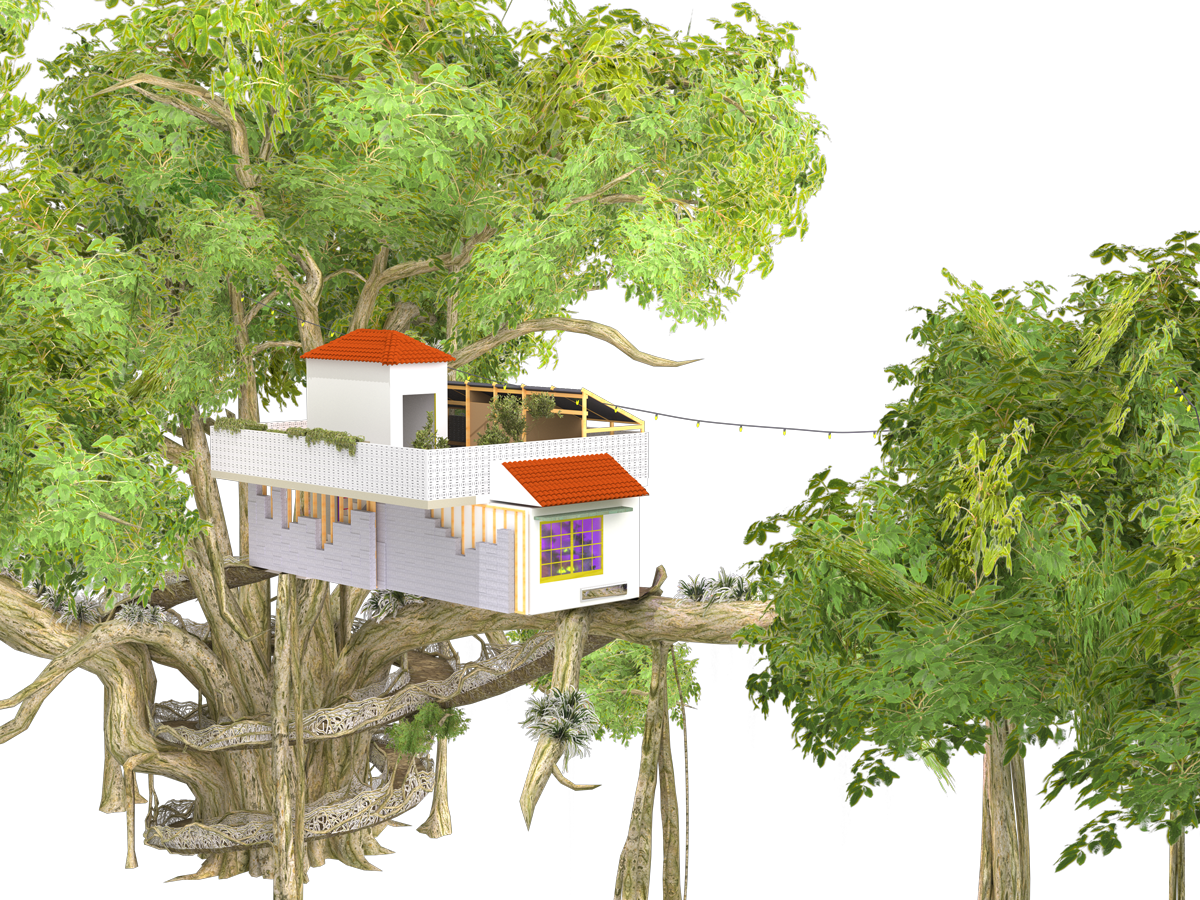
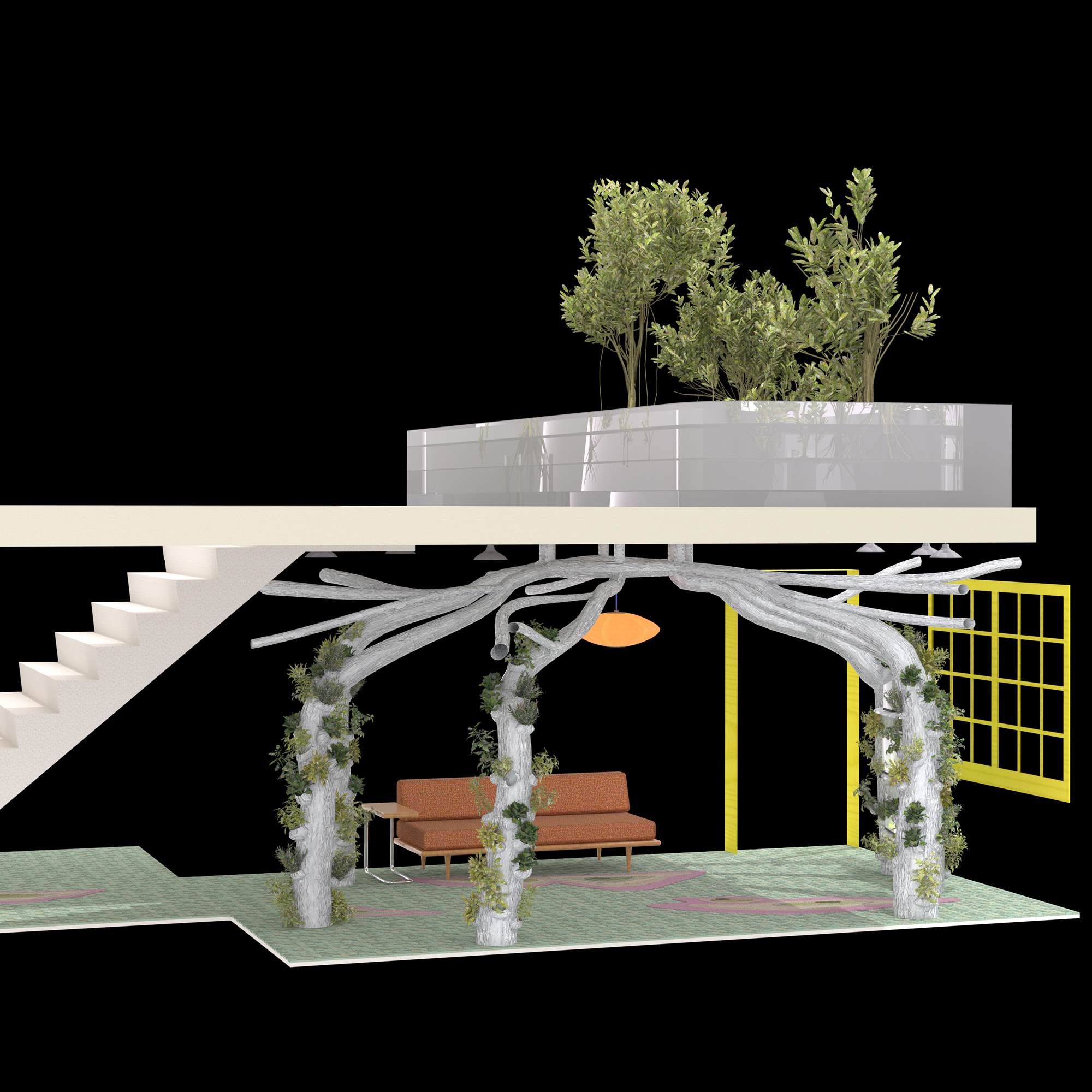
The design of the rooftop pond also follows the logic of biomimicry. Aquaponic systems often utilize a bell-siphon that partially drains the fish pond, sending water to the plants before returning it to the pond. When I learned about this design, I was fascinated by how it essentially replicates a tidal environment, and I wanted to emphasize that with the species in the tank: Mangrove trees that thrive in these tidal ecosystems and Tilapia. This fish is often raised in aquaponic systems but is invasive in the Everglades. Tilapia would be caught wild, removed from the ecosystems they are disrupting, held in the pond to increase the nutrient levels for plants, and eventually consumed. Eating this introduced species plays into the strange Florida subculture of Invasivores that forage and eat plants and animals that have been introduced to and are disrupting native ecosystems. Because Florida leads the world in introduced species, all kinds of oddities are on the menu in Miami, including iguanas, pythons, wild boars, and lionfish.



The rest of The Living Room follows a relatively standard apartment layout. Notable exceptions include a series of shelves in the kitchen that are growing oyster mushrooms, a rooftop pollinator garden, and a solar shed that combines a solar array with a shade house holding a chicken coop and compost station. My favorite Florida detail is the Surrounded Islands-inspired tufted rugs that flow from room to room.
In these renderings, the apartment has been severed from its surrounding building complex and is placed high up in a Strangler Fig tree. This decision is meant to create a visual connection between the biomorphic aquaponic system and these incredible architectural trees, as well as challenge conventional architectural renderings and the visions of the future they illustrate. The Living Room is a proposal, and the exact design of the living systems entangled with the dwelling would need to be elaborated further when an actual property is secured.

The Living Room evolved out of an ideation process that incorporated 3D modelling, AI image generators, and physical sculpting with mangroves, plaster, epoxy, and misc natural materials.
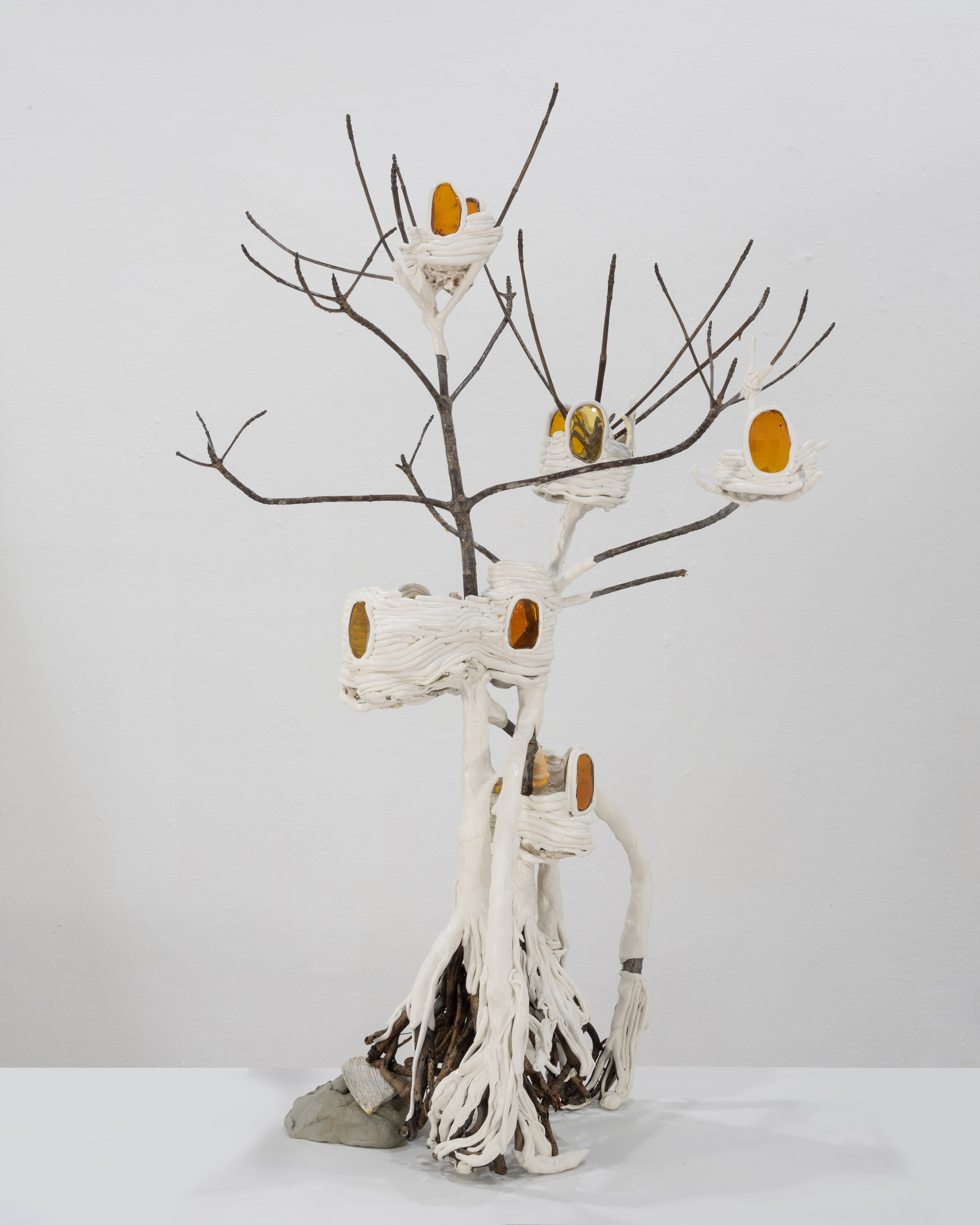
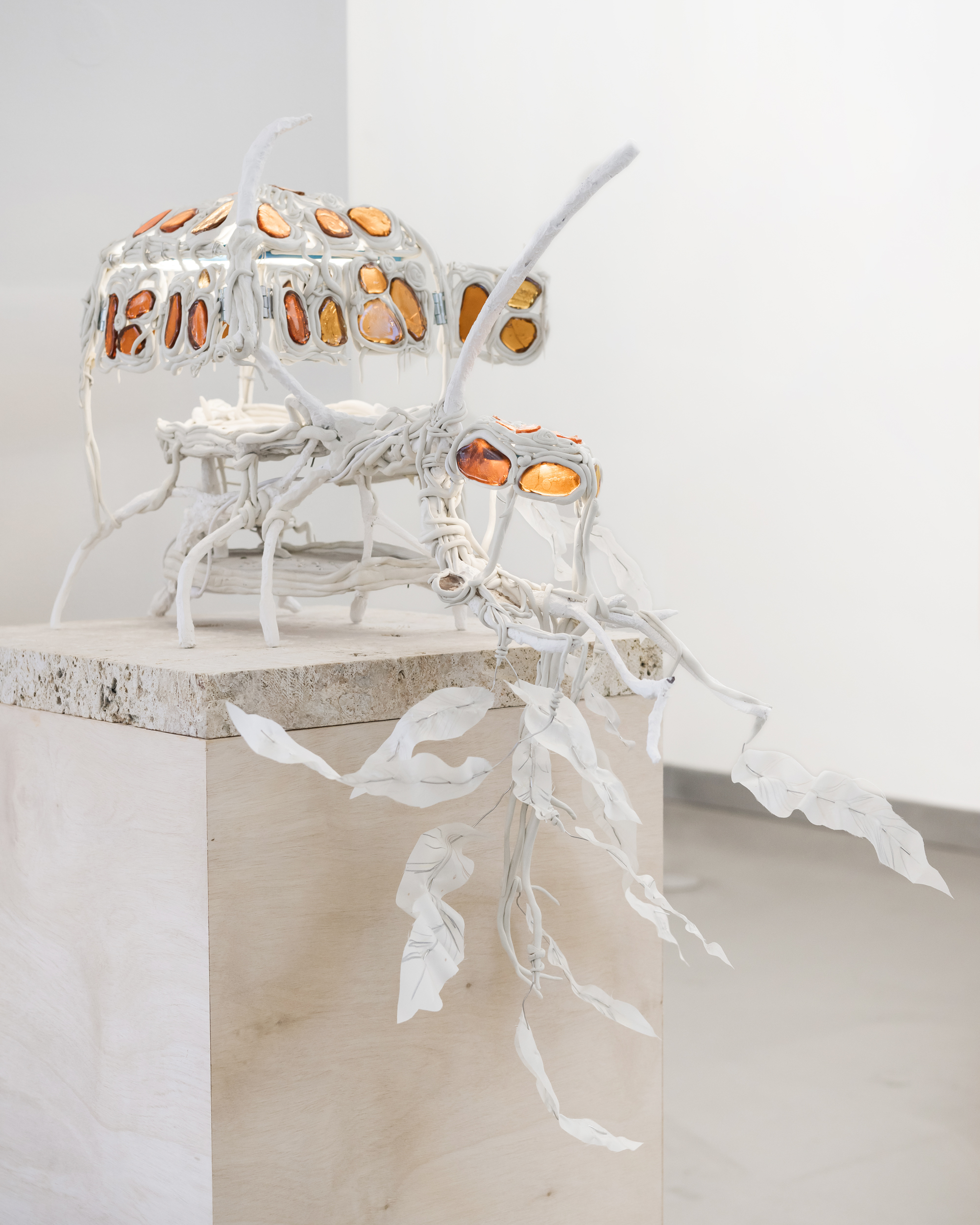
(Left)
Exo Exo (2021)
Intertwined mangrove pair (grown from seeds), tung oil, bray-poxy, moth, slash pine gum rosin,
oyster, clam, and coquina shells, stones, plasticine
(Right)
Epiphyte (2022)
Mangrove branches, plaster, epoxy, slash pine rosin, cement, LEDs, pearl, opal, opalized ammonite, glass gemstone, oyster, wire, fabric
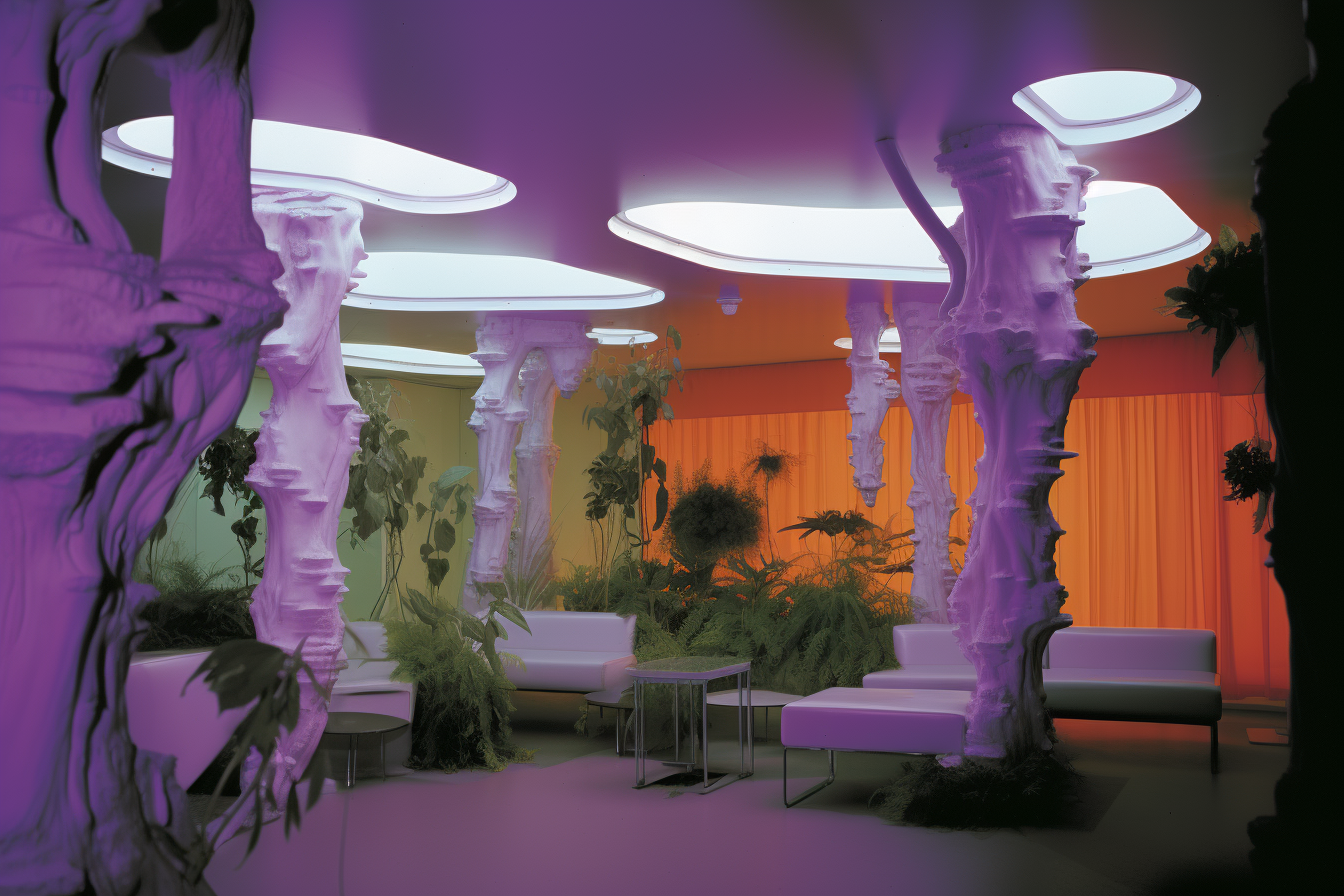


1- Composite image (/blend) of images 2+3.
2- Vintage florida postcard photo showing interior tiny Miami Beach apartment with vertical columns hydroponic herb garden farm
3- Right/ Bottom : Photo of interior of tiny 1980s Miami Beach Florida apartment with giant plaster tree stumps used as hydroponic farm, purple UV Fluorescent light

